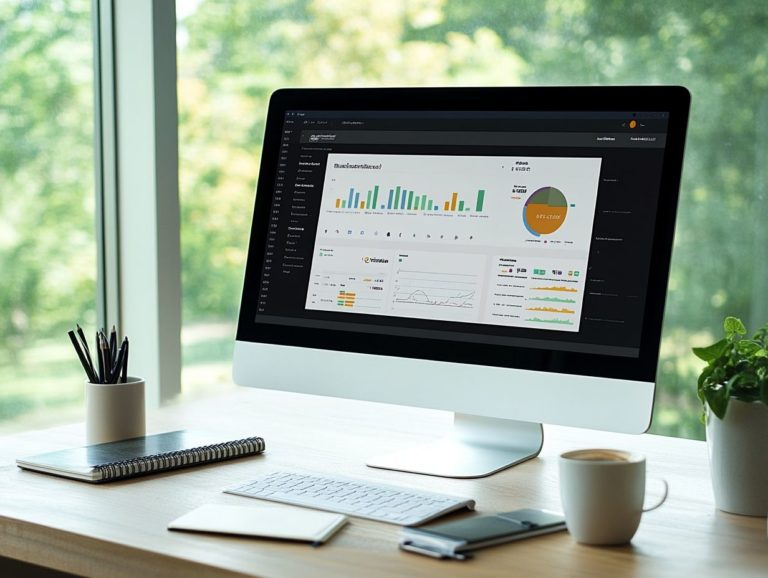Using Analytics to Improve Your Conversion Rates
In today s digital landscape, grasping conversion rates is essential for any business that aspires to excel online. This article carefully explains the fundamentals of conversion rates, illuminating their definition and importance.
You ll discover the key metrics to monitor, explore popular analytics tools for data collection, and learn methods for interpreting that data to glean actionable insights.
With real-life case studies showcasing successful optimization strategies and best practices for enhancing results, you ll acquire the expertise necessary to elevate your conversion rates effectively. Don t wait to improve your conversion rates!
Contents
- Key Takeaways:
- Understanding Conversion Rates
- Key Metrics for Measuring Conversion Rates
- Using Analytics Tools to Analyze Conversion Rates
- Interpreting and Applying Analytics Data
- Case Studies: Successful Use of Analytics for Conversion Rate Optimization
- Best Practices for Utilizing Analytics for Conversion Rate Improvement
- Frequently Asked Questions
- Using A/B Testing with Analytics to Boost Conversion Rates
- Avoiding Common Pitfalls in Analytics
- The Long-Term Benefits of Analytics
Key Takeaways:

- Understand the definition and importance of conversion rates to optimize your website’s performance.
- Identify and track important data metrics to better analyze and improve your conversion rates.
- Utilize popular analytics tools and best practices to interpret and apply data for successful conversion rate optimization.
Understanding Conversion Rates
Grasping conversion rates is essential for any digital marketing strategy, as it reveals how effectively your campaigns transform visitors into customers.
By leveraging tools like Visitor Behavior Analytics, you can gain profound insights into user behavior, enabling you to track the entire customer journey and refine your conversion metrics.
With access to data-driven insights, you can pinpoint areas for improvement, enhance user interactions, and ultimately elevate your conversion rates.
Definition and Importance
Conversion rates are essentially the percentage of visitors to your website who take a desired action, like making a purchase or signing up for your newsletter. This makes it a crucial metric in the realm of digital marketing.
By grasping the significance of conversion rates, you can effectively assess the success of your marketing strategies. This metric offers valuable insights into how adeptly your website transforms occasional visitors into paying customers or engaged subscribers, which is vital for maximizing your return on investment (ROI).
For example, WordStream’s research indicates that the average conversion rate across various industries hovers around 2.35%, while the top 25% of websites achieve rates of 5.31% or higher.
By dissecting these rates, you can pinpoint areas ripe for improvement, such as refining landing pages or enhancing the overall user experience.
This inevitably paves the way for increased sales and bolstered customer loyalty. In today’s fiercely competitive marketplace, understanding and elevating your conversion rates can be the key to your success.
Key Metrics for Measuring Conversion Rates
Effectively measuring conversion rates demands a clear understanding of key metrics that offer invaluable insights into user engagement and behavior.
By analyzing metrics like bounce rates (the percentage of visitors who leave a site after viewing only one page), engagement statistics, and traffic sources, you can segment your audience with precision, pinpoint your ideal customer, and refine your strategies for enhanced results.
This approach not only sharpens your focus but also enables you to optimize outcomes in a meaningful way.
Identifying and Tracking Important Data
Identifying and tracking important data is essential for you to understand user behavior and enhance conversion rates, as it enables the evaluation of your marketing effectiveness.
By utilizing analytics tools, you can pinpoint key areas to focus on, ensuring you capture the essential data needed for thorough analysis. These tools, ranging from Google Analytics to sophisticated customer relationship management (CRM) systems, allow you to track user interactions across various platforms.
Implementing A/B testing can help you refine your understanding by comparing different user experiences, ultimately enhancing overall engagement.
Monitoring metrics like bounce rates, time spent on pages, and conversion funnels will help you identify patterns in user behavior. Collectively, these methods enable you to make data-driven decisions and optimize your marketing strategies with precision.
Using Analytics Tools to Analyze Conversion Rates

Utilizing analytics tools is essential for any business aiming to effectively analyze conversion rates. These tools offer vital data and insights that inform your decisions.
Popular options such as Google Analytics, HotJar, and VWO enable marketers to conduct A/B testing comparing two versions of a webpage leverage heatmaps, and analyze form interactions.
Together, these capabilities significantly deepen your understanding of user behavior and engagement. They lead to more informed strategic choices.
Overview of Popular Analytics Tools
Analytics tools like Google Analytics and VWO are essential for gaining insights into user behavior and conversion rates. These platforms enable you to analyze data, visualize user interactions through heatmaps, and conduct targeted A/B testing.
By leveraging these powerful resources, you can uncover patterns and trends that might otherwise slip under the radar. For instance, Google Analytics not only tracks web traffic; it also offers segmentation capabilities to help you identify high-converting demographics.
HotJar enhances this by incorporating session recordings, allowing you to observe real-time user interactions and understand any navigation struggles they may face. VWO provides robust testing features to experiment with different site variations, enhancing user experiences and driving conversions.
Together, these tools form a dynamic framework that helps you refine your marketing strategies, personalize your content, and increase your return on investment.
Interpreting and Applying Analytics Data
Understanding analytics data is crucial for optimizing your conversion rates. The insights you glean can significantly shape the entire user experience, especially when utilizing data-driven decisions for conversions.
With effective data analysis, you can pinpoint customer pain points and grasp click patterns. Implement dynamic number insertion strategies to elevate your overall conversion optimization efforts.
Methods for Improving Conversion Rates
Implement effective methods to improve your conversion rates by tapping into analytics data to understand user behavior and preferences. Personalization strategies like tailored content and offers can dramatically enhance user experience and drive higher conversion rates.
To achieve this, employ advanced segmentation techniques to target specific audiences based on their previous interactions or demographics. For example, A/B testing can reveal which variations of your landing pages resonate best with your audience.
Integrating dynamic content that adapts based on user behavior keeps potential customers engaged and boosts the likelihood of conversion. Implement chatbots that offer real-time assistance and recommendations to guide users seamlessly through their purchasing journey, resulting in higher satisfaction and better outcomes.
Case Studies: Successful Use of Analytics for Conversion Rate Optimization
Explore successful case studies to discover how analytics can boost your digital marketing efforts. Companies that effectively use customer data often witness remarkable improvements in ROI by implementing customized strategies informed by insights from their analytics tools.
Real-Life Examples and Results

Discover how companies are boosting their sales through smart decisions based on data. You can also see impressive improvements in your own conversion success!
Take, for instance, an e-commerce titan like Amazon. They utilize robust A/B testing testing two versions of a webpage to see which one performs better to refine their user experience. This approach resulted in a staggering 300% increase in conversions for specific product pages.
Similarly, Airbnb harnesses advanced segmentation techniques to personalize their marketing efforts, leading to a significant boost in booking rates.
Another noteworthy example is ASOS, the online clothing retailer. They employed heatmaps to track customer interactions. This allowed them to simplify navigation and enhance product recommendations, elevating their overall conversion rate by an impressive margin.
These examples underscore how thoughtful analytics can transform business outcomes and significantly enhance user satisfaction.
Best Practices for Utilizing Analytics for Conversion Rate Improvement
By implementing best practices for utilizing analytics, you can significantly elevate your conversion rate improvement efforts. This structured approach allows you to gain a deeper understanding of user interactions while maximizing marketing attribution.
When you adopt effective personalization strategies, you can tailor your offerings to meet the specific needs and preferences of your target audience. This ultimately drives better conversion outcomes.
Tips and Strategies for Maximizing Results
To truly maximize your results in conversion rate optimization, it s essential to implement targeted tips and strategies that enhance your understanding of user behavior and preferences. These strategies can vary widely, from A/B testing to refining user experience through personalized content.
Analytics tools provide data on metrics such as page views, bounce rates, and conversion paths. This information can pinpoint specific areas of the conversion process that may need improvement.
By analyzing data from user interactions and conducting surveys, you can uncover pain points that might be hindering conversions. Prioritizing improvements like website loading speed and mobile responsiveness is crucial, as these elements significantly impact user engagement.
Integrating clear call-to-action buttons and simplifying navigation offers a smoother journey for potential customers. Utilizing high-quality visuals and testimonials not only fosters trust but also encourages users to take that important next step.
By combining these elements, you ll create a cohesive and inviting environment that attracts visitors and retains them, ultimately driving higher conversion rates.
Frequently Asked Questions
What is the importance of using analytics to improve conversion rates?
Analytics helps businesses track website traffic and customer behavior, offering valuable insights that can optimize conversion rates. This leads to more efficient marketing strategies, ultimately increasing revenue and profitability.
How can analytics help identify areas for improving conversion rates?

Analytics tools provide data on metrics such as page views, bounce rates, and conversion paths. This information can help pinpoint areas of the conversion process that may need improvement.
What types of analytics should be used to improve conversion rates?
There are various types of analytics that can be used, including web analytics, user behavior analytics, and conversion rate optimization analytics. Each type provides unique insights and can be combined for a comprehensive understanding of customer behavior and conversion rates.
Start implementing these strategies today for better results!
Using A/B Testing with Analytics to Boost Conversion Rates
A/B testing, or split testing, lets you compare two versions of a webpage or ad to find out which one works better. By tracking data from both versions, you can see which one attracts more customers and adjust accordingly.
Avoiding Common Pitfalls in Analytics
Many businesses make the mistake of only looking at overall conversion rates. It s crucial to dive deeper into specific metrics for better insights.
Another mistake is neglecting regular updates to your analytics strategies. Without fresh data and reviews, you might miss key growth opportunities.
The Long-Term Benefits of Analytics
Regularly monitoring customer data helps businesses make informed decisions. This approach leads to smarter marketing strategies and improved customer acquisition and retention.
Ultimately, these efforts can increase revenue and drive long-term success.






